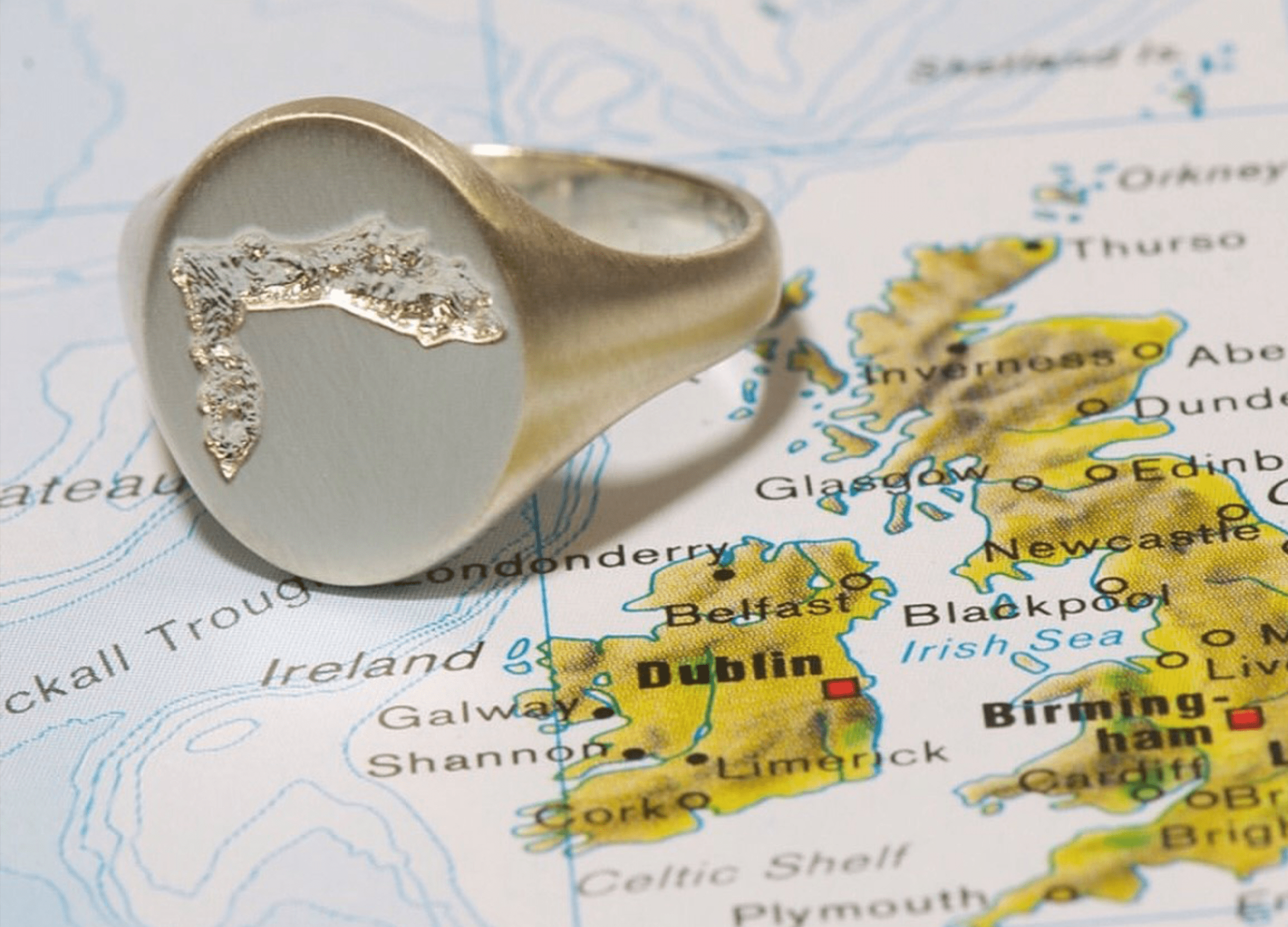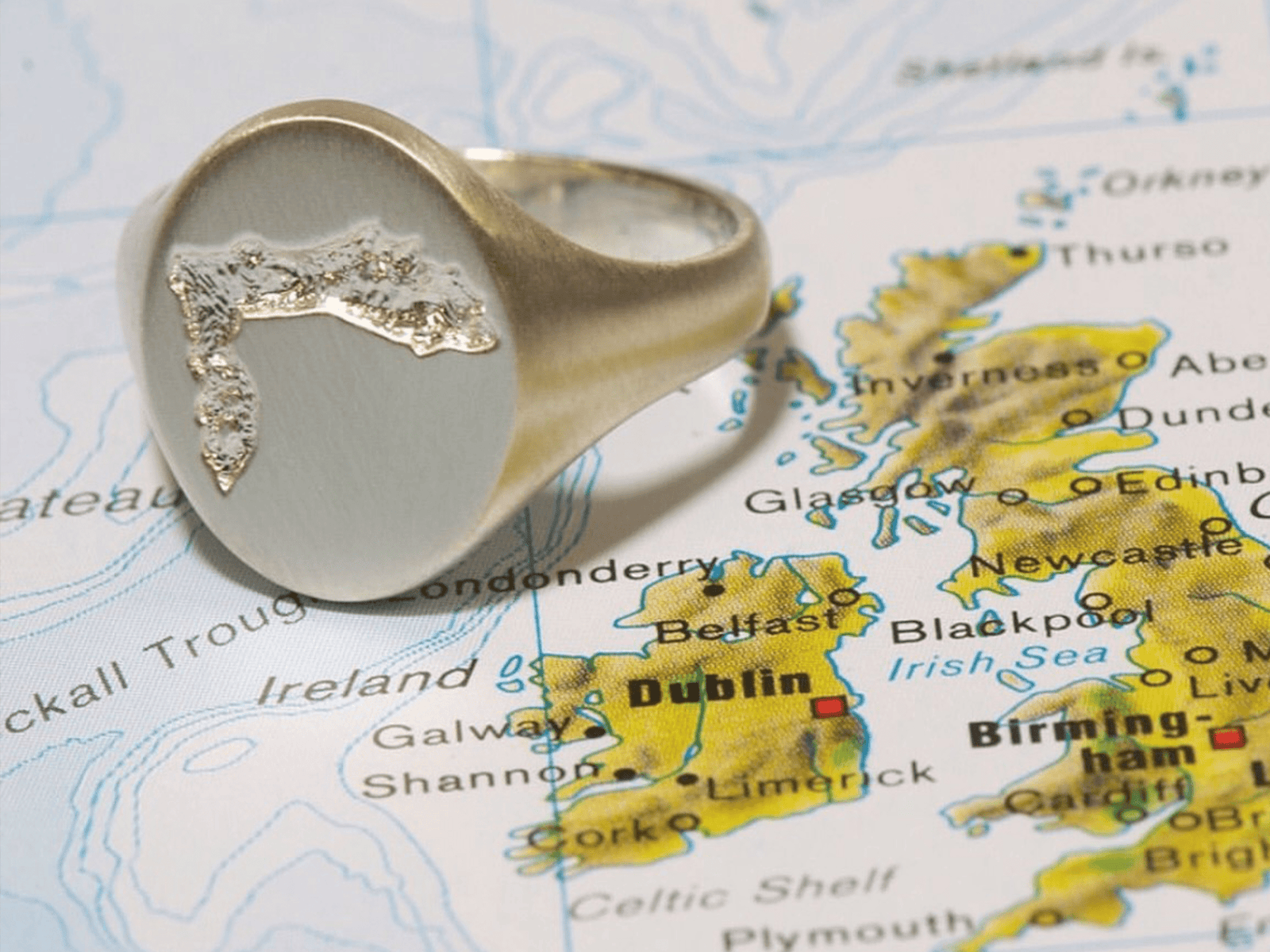Home holds diverse meanings for each of us, encompassing a wide spectrum of definitions that stretch across vast distances, cultures, and historical contexts. Join us on a journey that spans from the shores of Singapore to the untamed waters of Northern Ireland, as we explore symbols associated with the concepts of home and belonging. We'll unveil the captivating narratives behind cherished Rebus pieces, and uncover the family history behind a signet ring that honours a beloved grandmother.
Maps & borderlines
For those with a deep-rooted national pride or love of their hometowns, the outlines of cities, regions, and countries carry potent symbolism. From the borders of Brooklyn, to the cartographic contours of remote islands, maps and boundaries transcend lines, and for many, come to embody home and the people and locales they encompass.


[Image: A positive relief engraving on our Yellow Gold Oxford 55 Signet Ring depicting the borders of Rathlin Island, Northern Ireland]
One recent commission - an engraved signet ring to celebrate a 40th birthday and the passing of a beloved grandmother - beautifully exemplifies this concept of home.
‘’The image is that of the island I grew up on, and where my parents still live. Rathlin Island is the only inhabited island off Northern Ireland and only has a population of about 150. I have many happy memories of a childhood there and it will always be a special place for me. I also remember my Godmother coming up from her home in Ballymacarbry to visit us and her sister - my mother - and spending some wonderful holidays with us. So much so, I gave her an image of the island for her 70th birthday a few years before she passed.”


Heraldry & Coats of Arms
A more traditional means of symbolising home and family heritage, heraldic emblems can tell a detailed story of lineage and belonging. For thousands of years, heraldry was a means of distinguishing between warring armies through symbols that identified allegiance, ancestry, and rank. From the 14th century, it became more recognisable in its current form, with heraldry passed down from generation to generation among noble families. Governing rules, set by the College of Arms, decreed hereditary transmission through surnames not individuals, and predominantly through the male line. While female descendants are entitled to bear coats of arms, these privileges extend to their offspring only through special royal decree. In modern times however, many now create their own ‘unofficial’ coat of arms, blending personal and familial motifs outside the jurisdiction of the College of Arms.


[Image: Yellow Gold Oxford 55 Signet Ring using the stag supporters from the customer's coat of arms and an engraving of their family seat]
Language
Whether an inscription in Arabic or an engraved insider written in Urdu, language can be a powerful connection with home and family. Cryptic languages like Pig Latin, or coded dialects such as Cockney rhyming slang can also forge connection within specific groups or connect us to certain people and places. These languages can signify intimacy, social class, or ancestry. Even dead languages like Latin or Ancient Greek can act as membership into exclusive circles; becoming enigmatic codes shared only among those initiated.
The compass
Guiding us to our desired destination, the compass has come to symbolise a sense of direction and trust. Since the first compass was invented in China between the 2nd century BC and 1st century AD, this tool has become a much loved symbol of home. Unwavering in their ability to orient us, the compass is seen as symbol of guardianship and protection. The word compass comes from the fusion of Latin words 'com' (meaning together) and 'passus' (meaning step). This etymology signifies the idea of journeying together, and reflects how travellers often adopt the compass as a protective talisman during voyages.


[Image: An outline of Singapore and accompanying compass on our Round Pendant in White Gold]
National & regional symbols
Countries are often closely associated with one or two symbols, such as the daffodil of Wales, or the Bald Eagle of the United States. Other nations are tied to emblems found on their flag, as we see with Canadian Maple Leaf. Within countries, there are regional and city-level symbols too.
In the US, states adopt official symbols; for example, New York embraces the beaver and bluebird as its state animal and bird. Global megacities like NYC also boast their own array of unofficial symbols. Ranging from the Statue of Liberty and the Big Apple, to the quintessential hot dog and yellow taxi, these totems of urban life have come to embody the city's spirit.
Other cities are more intrinsically bonded with a single symbol. In Manchester, the Bee - emblematic of the Mancunian work ethic - has become a lasting emblem of the city's status as a hive of industry over the 150 years since the Industrial Revolution. This enduring motif decorates important landmarks such as the Manchester City Hall and Manchester Central train station.


[Image: An insider engraving on our Yellow Gold Oxford 55 Signet Ring outlines the borders of the borough of Brooklyn in New York]
We would love to help you get back in touch with your roots. If you would like to speak with one of our specialists about designing a Rebus piece engraved with your own personal symbols of home and belonging, please get in touch at info@rebussignetrings.co.uk or book an appointment at our Hatton Garden workshop or via Zoom for a private consultation.

